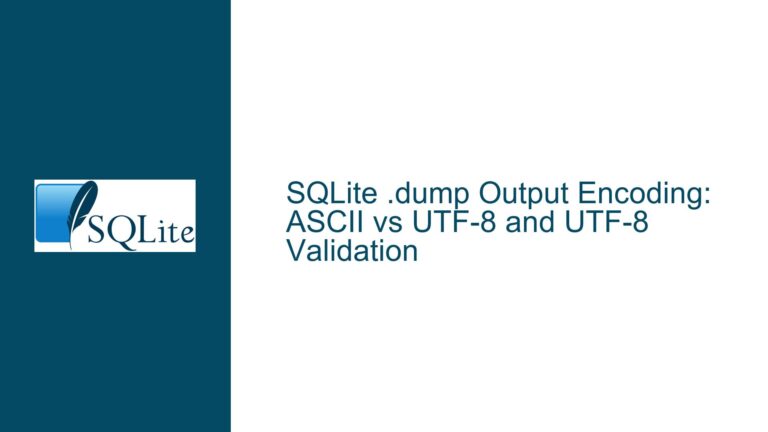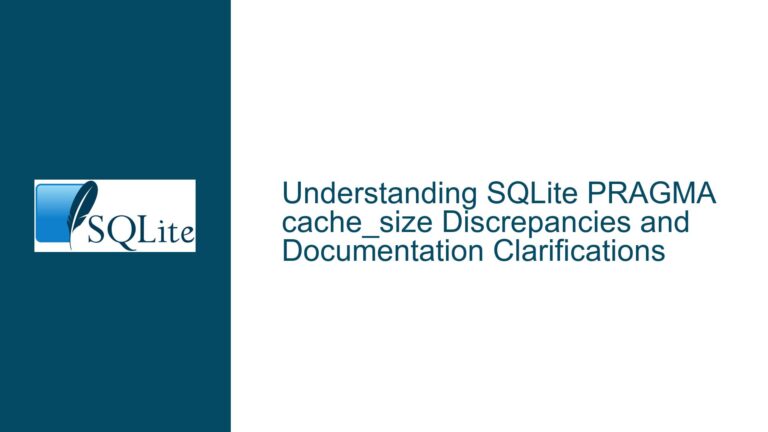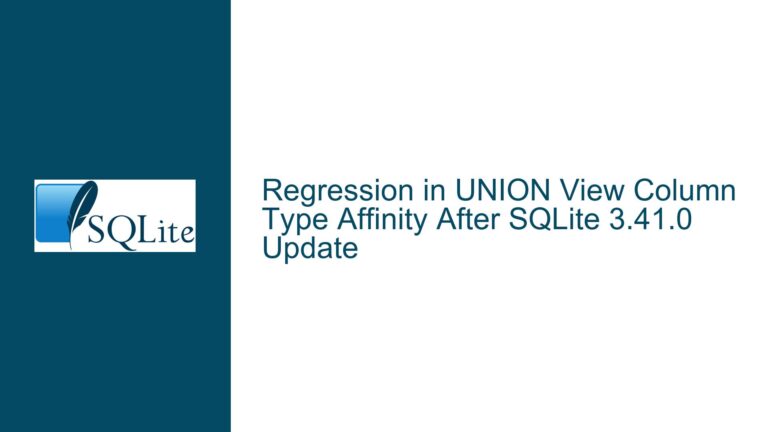SQLite .dbinfo Command Fails Due to Missing sqlite_dbpage Table
Database Configuration and Virtual Table Dependencies in SQLite
Issue Overview: .dbinfo Command Reliance on Virtual Tables and Compilation Flags
The core issue involves the failure of the .dbinfo command in the SQLite command-line interface (CLI) when attempting to retrieve database metadata. The error message no such table: sqlite_dbpage directly indicates that the CLI cannot access the internal virtual table sqlite_dbpage, which is required for .dbinfo to function. This problem arises due to the absence of specific compilation flags during the build process of the SQLite CLI tool. The sqlite_dbpage virtual table is part of the DBPAGE Virtual Table Extension, a component that provides low-level access to the database file structure. When the SQLite CLI is compiled without enabling this extension, the .dbinfo command cannot execute because its dependency on the sqlite_dbpage table remains unmet.
The .dbinfo command is designed to output critical database parameters such as page size, schema format, encoding, and storage statistics. These details are essential for diagnosing performance issues, verifying database integrity, and understanding storage efficiency. The sqlite_dbpage virtual table acts as an interface to the raw database pages, allowing the CLI to extract metadata directly from the binary structure of the database file. Without this interface, the CLI lacks the necessary mechanism to gather the required information. The problem is exacerbated by conditional compilation directives in SQLite’s source code: If the SQLITE_ENABLE_DBPAGE_VTAB flag is not defined during compilation, or if the SQLITE_OMIT_VIRTUALTABLE flag is defined, the virtual table subsystem is either partially or fully excluded from the build. This results in the unavailability of sqlite_dbpage and the subsequent failure of .dbinfo.
Possible Causes: Compilation Flags and Virtual Table Availability
Missing
SQLITE_ENABLE_DBPAGE_VTABCompilation Flag:
The SQLite build process uses preprocessor directives to include or exclude features. TheSQLITE_ENABLE_DBPAGE_VTABflag enables the DBPAGE virtual table extension. If this flag is absent during compilation, thesqlite_dbpagevirtual table is not included in the binary, rendering.dbinfonon-functional. This is common in precompiled SQLite binaries distributed with operating systems or package managers, which often exclude niche features to reduce binary size or attack surface.Presence of
SQLITE_OMIT_VIRTUALTABLECompilation Flag:
TheSQLITE_OMIT_VIRTUALTABLEflag explicitly disables all virtual table functionality in SQLite. Virtual tables are a mechanism for defining custom storage engines and interfaces to external data sources. When this flag is set, not only is the DBPAGE extension excluded, but all virtual table support is removed. This includes extensions likeFTS5(Full-Text Search) andRTREE(spatial indexing). If the CLI is built with this flag,.dbinfowill fail unconditionally.Incompatible Precompiled SQLite Binaries:
Many systems ship with SQLite binaries compiled using default settings, which may exclude the DBPAGE extension. For example, the SQLite version bundled with macOS or Linux distributions often prioritizes minimalism over niche debugging features. Users who install SQLite via system package managers (e.g.,apt,brew) without customizing compilation flags will encounter this issue.Version-Specific Build Configurations:
Older SQLite versions (prior to 3.38.2) may have different dependencies for.dbinfo. While the command has been available for several releases, its reliance on specific virtual tables can vary between versions. Upgrading SQLite without ensuring backward-compatible flags might reintroduce the problem if the build process is not carefully managed.
Troubleshooting Steps: Recompiling SQLite and Using Alternative Tools
Step 1: Verify SQLite Compilation Flags
Before recompiling SQLite, confirm whether the existing binary includes the DBPAGE extension. Execute the following command in the terminal:
sqlite3 -cmd ".shell echo 'SQLITE_ENABLE_DBPAGE_VTAB: ' || .show" | grep DBPAGE
If the output does not include SQLITE_ENABLE_DBPAGE_VTAB, the CLI lacks the necessary support. On macOS, the default SQLite binary is typically compiled without this flag. Proceed to recompile SQLite with the correct flags.
Step 2: Recompile SQLite with DBPAGE Virtual Table Support
Download the SQLite source code from the official website. Extract the source archive and navigate to the directory. Use the following commands to configure and build SQLite with the required flags:
./configure CFLAGS="-DSQLITE_ENABLE_DBPAGE_VTAB"
make
sudo make install
This compiles SQLite with the SQLITE_ENABLE_DBPAGE_VTAB flag enabled. For users who require additional features (e.g., JSON1, FTS5), append -DSQLITE_ENABLE_JSON1 -DSQLITE_ENABLE_FTS5 to the CFLAGS variable. After installation, verify the build:
sqlite3 -cmd ".show" | grep DBPAGE
The output should confirm that SQLITE_ENABLE_DBPAGE_VTAB is defined.
Step 3: Use the sqlite3 CLI with DBPAGE Support
After recompiling, launch the CLI and execute .dbinfo:
sqlite3 your_database.db
.dbinfo
The command should now output database statistics without errors. If the problem persists, ensure that no conflicting flags (e.g., SQLITE_OMIT_VIRTUALTABLE) are present in the build configuration.
Step 4: Leverage sqlite_analyzer as an Alternative
If recompiling SQLite is impractical, use the sqlite_analyzer tool, which provides detailed database metadata without relying on .dbinfo. Download the precompiled binary from the SQLite website or build it from source. Execute it as follows:
sqlite_analyzer your_database.db
This tool generates a comprehensive report including table sizes, index usage, and page allocation. While its output format differs from .dbinfo, it serves as a viable workaround for diagnosing database issues.
Step 5: Check for System-Specific Build Issues on macOS
macOS’s default SQLite installation (via Xcode or command-line tools) is optimized for system services and may resist replacement. Users can install a custom SQLite build using Homebrew:
brew install sqlite3 --with-dbpage-vtab
If the --with-dbpage-vtab option is unavailable, manually edit the Homebrew formula to include the required CFLAGS.
Step 6: Validate Virtual Table Functionality
To confirm that virtual tables are operational, create a test virtual table:
CREATE VIRTUAL TABLE testvt USING dbpage;
If this command succeeds, the DBPAGE extension is active. If it fails with an error (e.g., no such module: dbpage), the compilation flags were not applied correctly.
Step 7: Inspect SQLite Runtime Configuration
SQLite’s runtime configuration can be queried using the .show command in the CLI:
.show
Look for lines indicating SQLITE_ENABLE_DBPAGE_VTAB or SQLITE_OMIT_VIRTUALTABLE. This helps identify whether the CLI’s current instance supports the required features.
Step 8: Cross-Platform Considerations
Windows users may encounter additional challenges due to the lack of a native package manager. Precompiled binaries for Windows are available from the SQLite website, but they may exclude the DBPAGE extension. Users should download the "amalgamation" source code and compile it manually using Visual Studio or MinGW, ensuring that SQLITE_ENABLE_DBPAGE_VTAB is defined.
Step 9: Debugging Build Scripts and Environment Variables
If manual compilation fails, inspect environment variables that might override CFLAGS, such as CPPFLAGS or CXXFLAGS. Build systems like Autotools or CMake may require explicit flag forwarding. For example, in a CMake project:
add_definitions(-DSQLITE_ENABLE_DBPAGE_VTAB)
Step 10: Long-Term Maintenance and Updates
Monitor SQLite’s release notes for changes to the .dbinfo command or virtual table dependencies. Subscribe to the SQLite mailing list or GitHub repository for notifications about build flag adjustments. When upgrading SQLite, reapply custom compilation flags to ensure continued compatibility with .dbinfo.
By systematically addressing compilation flags, validating virtual table support, and leveraging alternative tools, users can resolve the .dbinfo error and gain deeper insights into their SQLite databases.






